Health Assessment Essay: Nursing Practice, Patient Care, and Settings
VerifiedAdded on 2023/06/04
|8
|2107
|356
Essay
AI Summary
This essay provides a comprehensive overview of health assessment in nursing practice. It begins by defining health assessment and outlining its key components, including physical assessment and health history. The essay then delves into the purpose of health assessment from a nursing perspective, emphasizing its role in data collection, clinical judgment, and patient care planning. It highlights how health assessment enables nurses to identify patient needs, strengths, and weaknesses, and how it guides appropriate interventions and care strategies. The essay further explores how health assessment is conducted differently across various settings, using examples of a child in a community setting and an elderly person in an aged care facility to illustrate these differences. It emphasizes the importance of adapting assessment techniques based on the patient's age, communication abilities, and the specific healthcare environment. The essay concludes by reiterating the significance of health assessment in guiding nursing care and making informed clinical judgments, ultimately contributing to improved patient outcomes. The essay draws from scholarly literature to support its arguments and provide a solid foundation for understanding the critical role of health assessment in nursing.
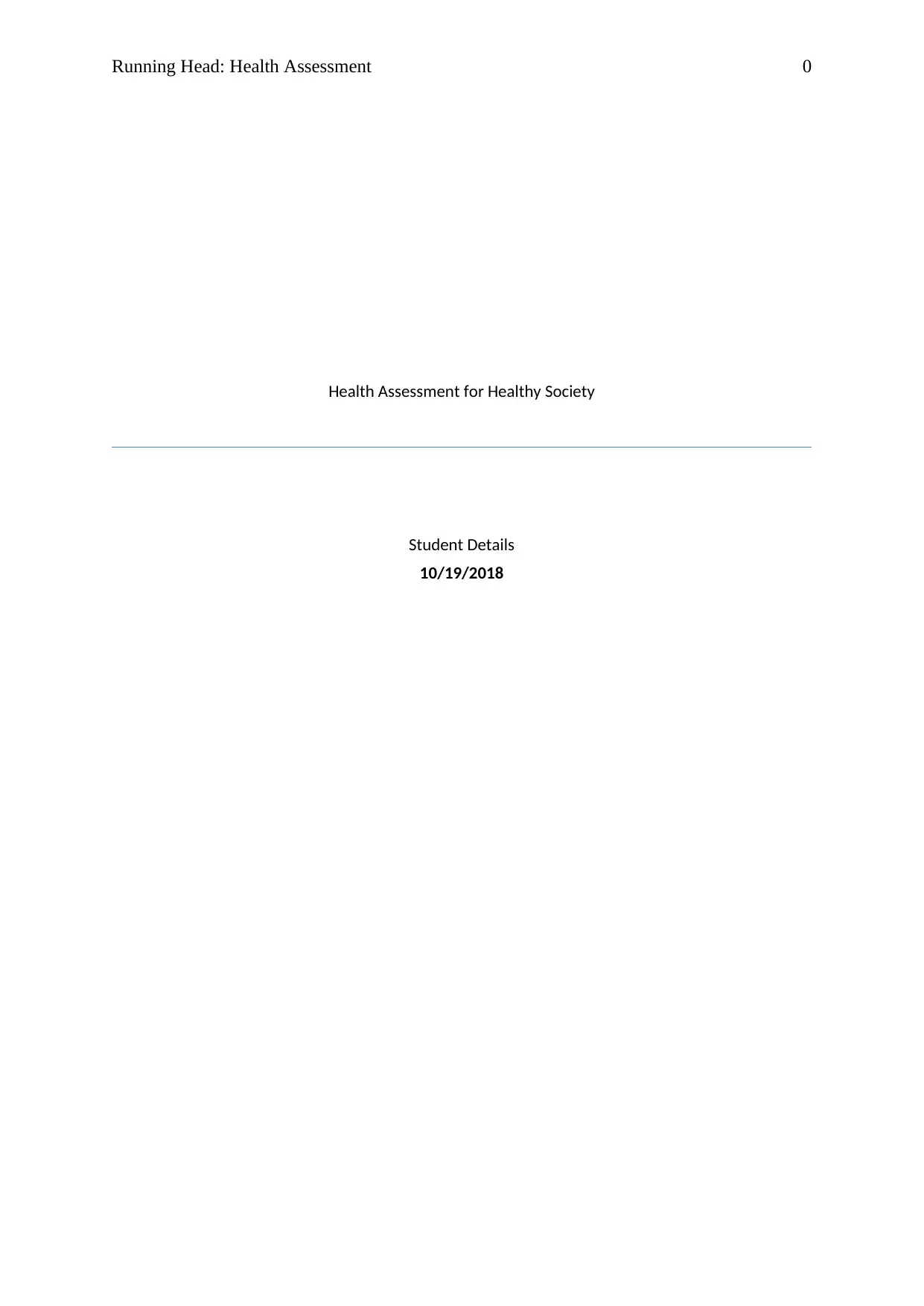
Running Head: Health Assessment 0
Health Assessment for Healthy Society
Student Details
10/19/2018
Health Assessment for Healthy Society
Student Details
10/19/2018
Paraphrase This Document
Need a fresh take? Get an instant paraphrase of this document with our AI Paraphraser
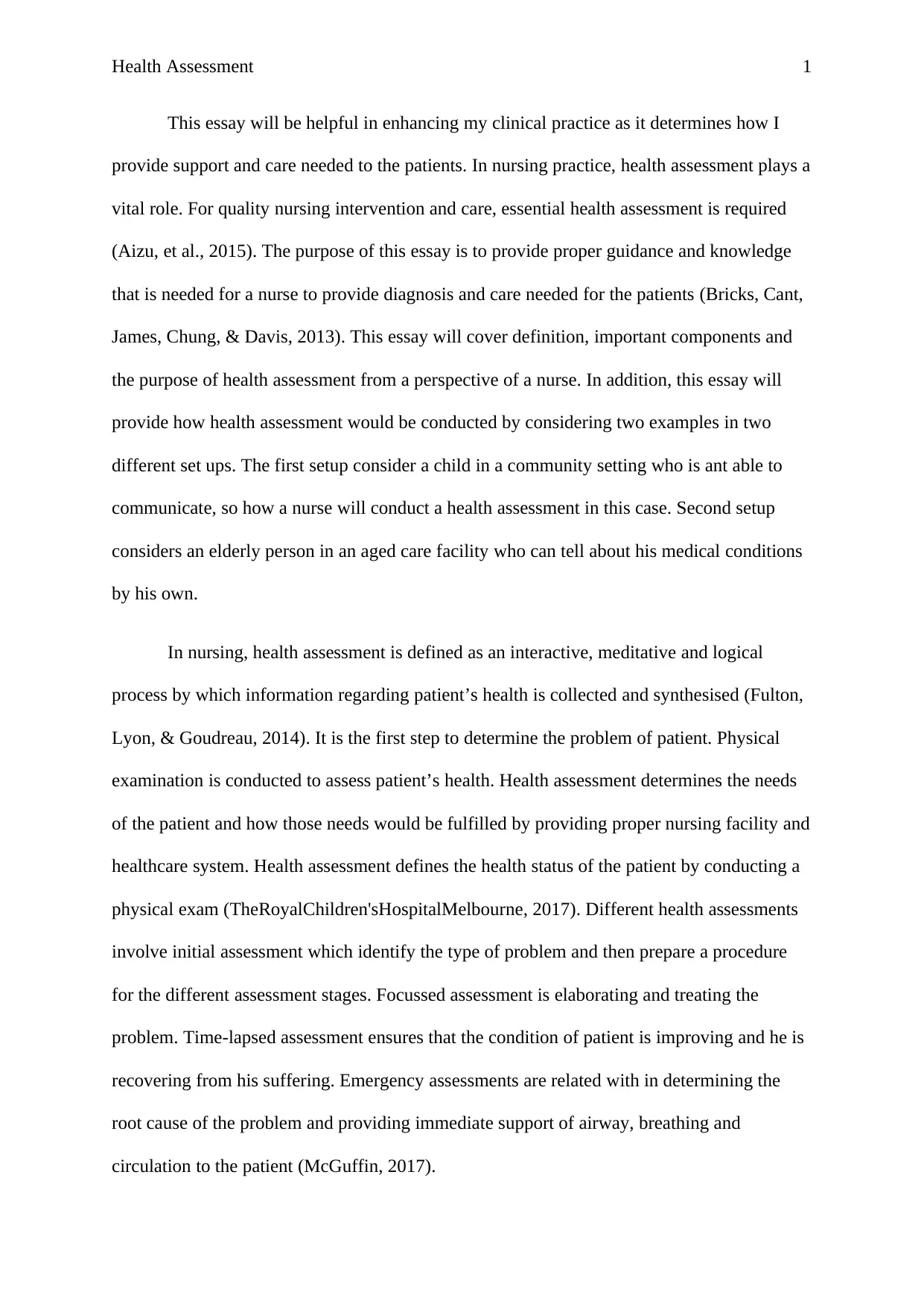
Health Assessment 1
This essay will be helpful in enhancing my clinical practice as it determines how I
provide support and care needed to the patients. In nursing practice, health assessment plays a
vital role. For quality nursing intervention and care, essential health assessment is required
(Aizu, et al., 2015). The purpose of this essay is to provide proper guidance and knowledge
that is needed for a nurse to provide diagnosis and care needed for the patients (Bricks, Cant,
James, Chung, & Davis, 2013). This essay will cover definition, important components and
the purpose of health assessment from a perspective of a nurse. In addition, this essay will
provide how health assessment would be conducted by considering two examples in two
different set ups. The first setup consider a child in a community setting who is ant able to
communicate, so how a nurse will conduct a health assessment in this case. Second setup
considers an elderly person in an aged care facility who can tell about his medical conditions
by his own.
In nursing, health assessment is defined as an interactive, meditative and logical
process by which information regarding patient’s health is collected and synthesised (Fulton,
Lyon, & Goudreau, 2014). It is the first step to determine the problem of patient. Physical
examination is conducted to assess patient’s health. Health assessment determines the needs
of the patient and how those needs would be fulfilled by providing proper nursing facility and
healthcare system. Health assessment defines the health status of the patient by conducting a
physical exam (TheRoyalChildren'sHospitalMelbourne, 2017). Different health assessments
involve initial assessment which identify the type of problem and then prepare a procedure
for the different assessment stages. Focussed assessment is elaborating and treating the
problem. Time-lapsed assessment ensures that the condition of patient is improving and he is
recovering from his suffering. Emergency assessments are related with in determining the
root cause of the problem and providing immediate support of airway, breathing and
circulation to the patient (McGuffin, 2017).
This essay will be helpful in enhancing my clinical practice as it determines how I
provide support and care needed to the patients. In nursing practice, health assessment plays a
vital role. For quality nursing intervention and care, essential health assessment is required
(Aizu, et al., 2015). The purpose of this essay is to provide proper guidance and knowledge
that is needed for a nurse to provide diagnosis and care needed for the patients (Bricks, Cant,
James, Chung, & Davis, 2013). This essay will cover definition, important components and
the purpose of health assessment from a perspective of a nurse. In addition, this essay will
provide how health assessment would be conducted by considering two examples in two
different set ups. The first setup consider a child in a community setting who is ant able to
communicate, so how a nurse will conduct a health assessment in this case. Second setup
considers an elderly person in an aged care facility who can tell about his medical conditions
by his own.
In nursing, health assessment is defined as an interactive, meditative and logical
process by which information regarding patient’s health is collected and synthesised (Fulton,
Lyon, & Goudreau, 2014). It is the first step to determine the problem of patient. Physical
examination is conducted to assess patient’s health. Health assessment determines the needs
of the patient and how those needs would be fulfilled by providing proper nursing facility and
healthcare system. Health assessment defines the health status of the patient by conducting a
physical exam (TheRoyalChildren'sHospitalMelbourne, 2017). Different health assessments
involve initial assessment which identify the type of problem and then prepare a procedure
for the different assessment stages. Focussed assessment is elaborating and treating the
problem. Time-lapsed assessment ensures that the condition of patient is improving and he is
recovering from his suffering. Emergency assessments are related with in determining the
root cause of the problem and providing immediate support of airway, breathing and
circulation to the patient (McGuffin, 2017).
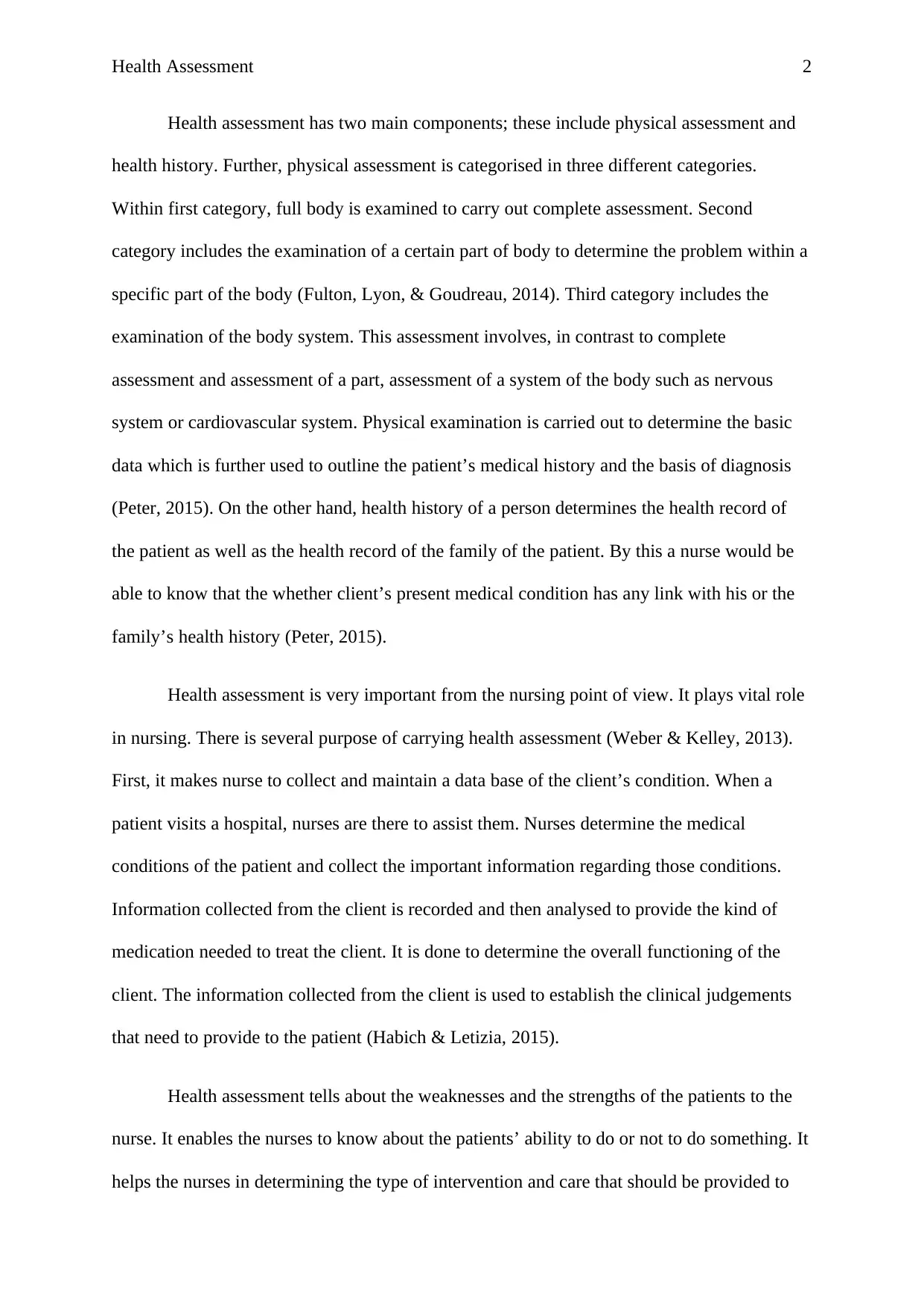
Health Assessment 2
Health assessment has two main components; these include physical assessment and
health history. Further, physical assessment is categorised in three different categories.
Within first category, full body is examined to carry out complete assessment. Second
category includes the examination of a certain part of body to determine the problem within a
specific part of the body (Fulton, Lyon, & Goudreau, 2014). Third category includes the
examination of the body system. This assessment involves, in contrast to complete
assessment and assessment of a part, assessment of a system of the body such as nervous
system or cardiovascular system. Physical examination is carried out to determine the basic
data which is further used to outline the patient’s medical history and the basis of diagnosis
(Peter, 2015). On the other hand, health history of a person determines the health record of
the patient as well as the health record of the family of the patient. By this a nurse would be
able to know that the whether client’s present medical condition has any link with his or the
family’s health history (Peter, 2015).
Health assessment is very important from the nursing point of view. It plays vital role
in nursing. There is several purpose of carrying health assessment (Weber & Kelley, 2013).
First, it makes nurse to collect and maintain a data base of the client’s condition. When a
patient visits a hospital, nurses are there to assist them. Nurses determine the medical
conditions of the patient and collect the important information regarding those conditions.
Information collected from the client is recorded and then analysed to provide the kind of
medication needed to treat the client. It is done to determine the overall functioning of the
client. The information collected from the client is used to establish the clinical judgements
that need to provide to the patient (Habich & Letizia, 2015).
Health assessment tells about the weaknesses and the strengths of the patients to the
nurse. It enables the nurses to know about the patients’ ability to do or not to do something. It
helps the nurses in determining the type of intervention and care that should be provided to
Health assessment has two main components; these include physical assessment and
health history. Further, physical assessment is categorised in three different categories.
Within first category, full body is examined to carry out complete assessment. Second
category includes the examination of a certain part of body to determine the problem within a
specific part of the body (Fulton, Lyon, & Goudreau, 2014). Third category includes the
examination of the body system. This assessment involves, in contrast to complete
assessment and assessment of a part, assessment of a system of the body such as nervous
system or cardiovascular system. Physical examination is carried out to determine the basic
data which is further used to outline the patient’s medical history and the basis of diagnosis
(Peter, 2015). On the other hand, health history of a person determines the health record of
the patient as well as the health record of the family of the patient. By this a nurse would be
able to know that the whether client’s present medical condition has any link with his or the
family’s health history (Peter, 2015).
Health assessment is very important from the nursing point of view. It plays vital role
in nursing. There is several purpose of carrying health assessment (Weber & Kelley, 2013).
First, it makes nurse to collect and maintain a data base of the client’s condition. When a
patient visits a hospital, nurses are there to assist them. Nurses determine the medical
conditions of the patient and collect the important information regarding those conditions.
Information collected from the client is recorded and then analysed to provide the kind of
medication needed to treat the client. It is done to determine the overall functioning of the
client. The information collected from the client is used to establish the clinical judgements
that need to provide to the patient (Habich & Letizia, 2015).
Health assessment tells about the weaknesses and the strengths of the patients to the
nurse. It enables the nurses to know about the patients’ ability to do or not to do something. It
helps the nurses in determining the type of intervention and care that should be provided to
⊘ This is a preview!⊘
Do you want full access?
Subscribe today to unlock all pages.

Trusted by 1+ million students worldwide
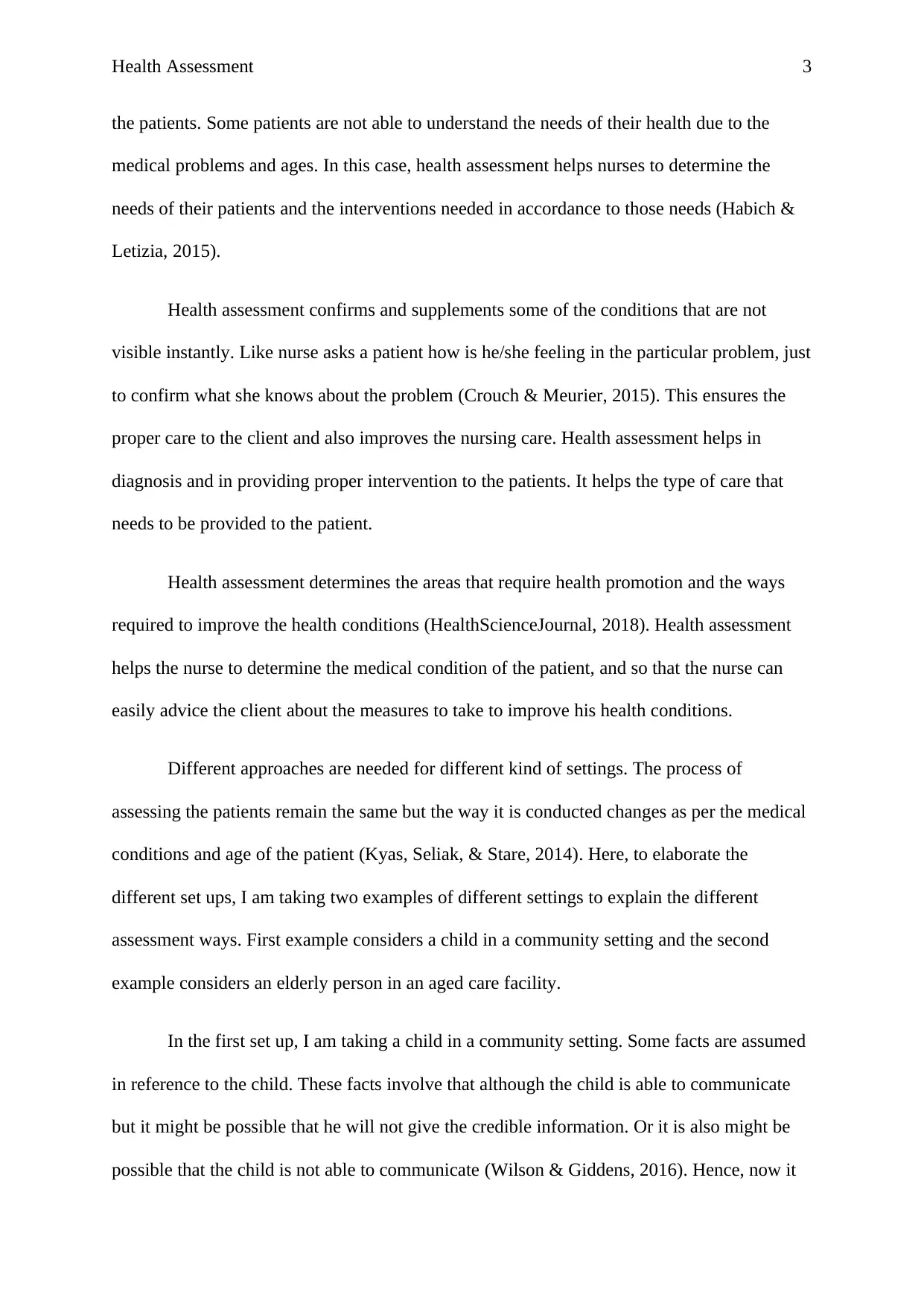
Health Assessment 3
the patients. Some patients are not able to understand the needs of their health due to the
medical problems and ages. In this case, health assessment helps nurses to determine the
needs of their patients and the interventions needed in accordance to those needs (Habich &
Letizia, 2015).
Health assessment confirms and supplements some of the conditions that are not
visible instantly. Like nurse asks a patient how is he/she feeling in the particular problem, just
to confirm what she knows about the problem (Crouch & Meurier, 2015). This ensures the
proper care to the client and also improves the nursing care. Health assessment helps in
diagnosis and in providing proper intervention to the patients. It helps the type of care that
needs to be provided to the patient.
Health assessment determines the areas that require health promotion and the ways
required to improve the health conditions (HealthScienceJournal, 2018). Health assessment
helps the nurse to determine the medical condition of the patient, and so that the nurse can
easily advice the client about the measures to take to improve his health conditions.
Different approaches are needed for different kind of settings. The process of
assessing the patients remain the same but the way it is conducted changes as per the medical
conditions and age of the patient (Kyas, Seliak, & Stare, 2014). Here, to elaborate the
different set ups, I am taking two examples of different settings to explain the different
assessment ways. First example considers a child in a community setting and the second
example considers an elderly person in an aged care facility.
In the first set up, I am taking a child in a community setting. Some facts are assumed
in reference to the child. These facts involve that although the child is able to communicate
but it might be possible that he will not give the credible information. Or it is also might be
possible that the child is not able to communicate (Wilson & Giddens, 2016). Hence, now it
the patients. Some patients are not able to understand the needs of their health due to the
medical problems and ages. In this case, health assessment helps nurses to determine the
needs of their patients and the interventions needed in accordance to those needs (Habich &
Letizia, 2015).
Health assessment confirms and supplements some of the conditions that are not
visible instantly. Like nurse asks a patient how is he/she feeling in the particular problem, just
to confirm what she knows about the problem (Crouch & Meurier, 2015). This ensures the
proper care to the client and also improves the nursing care. Health assessment helps in
diagnosis and in providing proper intervention to the patients. It helps the type of care that
needs to be provided to the patient.
Health assessment determines the areas that require health promotion and the ways
required to improve the health conditions (HealthScienceJournal, 2018). Health assessment
helps the nurse to determine the medical condition of the patient, and so that the nurse can
easily advice the client about the measures to take to improve his health conditions.
Different approaches are needed for different kind of settings. The process of
assessing the patients remain the same but the way it is conducted changes as per the medical
conditions and age of the patient (Kyas, Seliak, & Stare, 2014). Here, to elaborate the
different set ups, I am taking two examples of different settings to explain the different
assessment ways. First example considers a child in a community setting and the second
example considers an elderly person in an aged care facility.
In the first set up, I am taking a child in a community setting. Some facts are assumed
in reference to the child. These facts involve that although the child is able to communicate
but it might be possible that he will not give the credible information. Or it is also might be
possible that the child is not able to communicate (Wilson & Giddens, 2016). Hence, now it
Paraphrase This Document
Need a fresh take? Get an instant paraphrase of this document with our AI Paraphraser
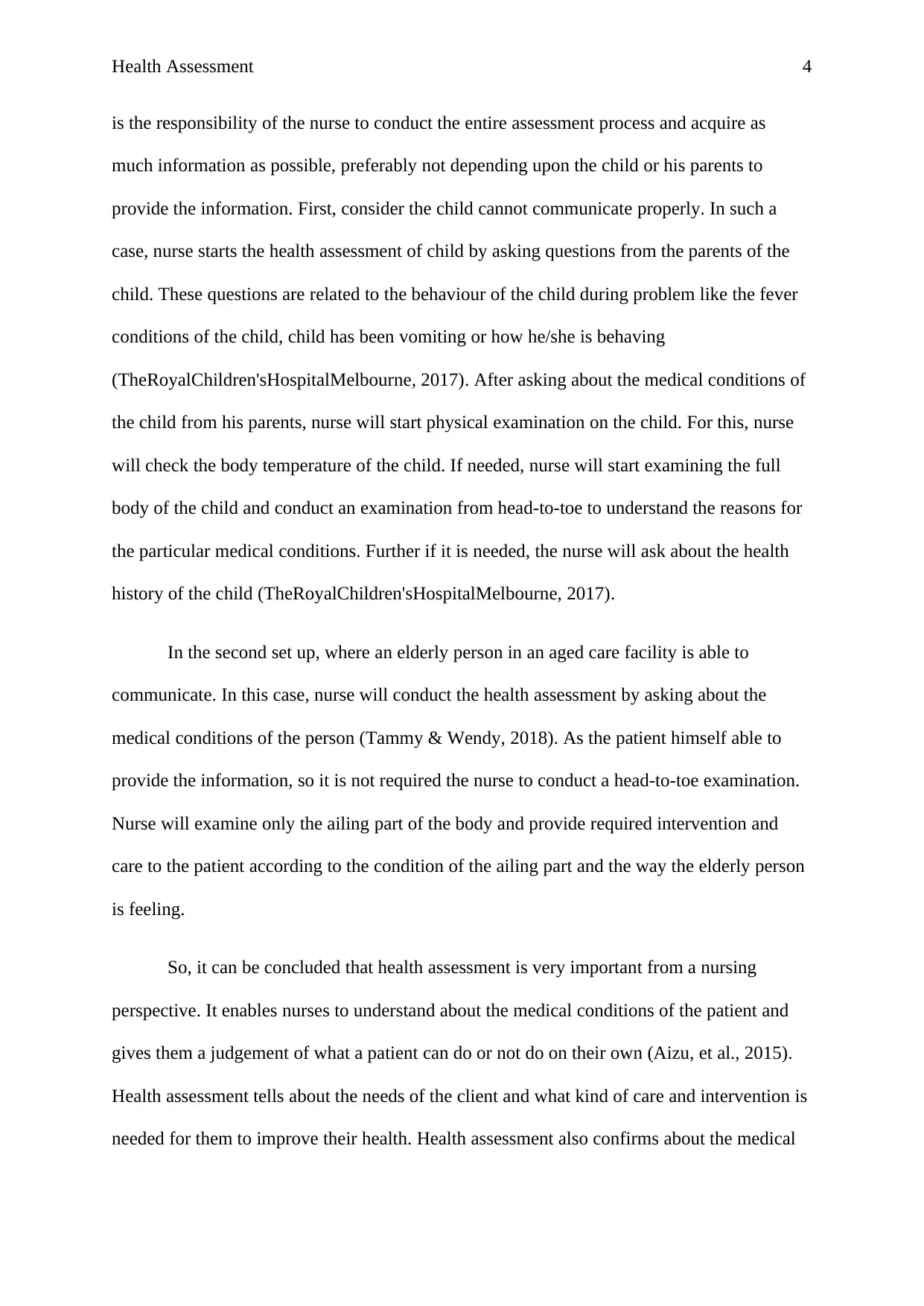
Health Assessment 4
is the responsibility of the nurse to conduct the entire assessment process and acquire as
much information as possible, preferably not depending upon the child or his parents to
provide the information. First, consider the child cannot communicate properly. In such a
case, nurse starts the health assessment of child by asking questions from the parents of the
child. These questions are related to the behaviour of the child during problem like the fever
conditions of the child, child has been vomiting or how he/she is behaving
(TheRoyalChildren'sHospitalMelbourne, 2017). After asking about the medical conditions of
the child from his parents, nurse will start physical examination on the child. For this, nurse
will check the body temperature of the child. If needed, nurse will start examining the full
body of the child and conduct an examination from head-to-toe to understand the reasons for
the particular medical conditions. Further if it is needed, the nurse will ask about the health
history of the child (TheRoyalChildren'sHospitalMelbourne, 2017).
In the second set up, where an elderly person in an aged care facility is able to
communicate. In this case, nurse will conduct the health assessment by asking about the
medical conditions of the person (Tammy & Wendy, 2018). As the patient himself able to
provide the information, so it is not required the nurse to conduct a head-to-toe examination.
Nurse will examine only the ailing part of the body and provide required intervention and
care to the patient according to the condition of the ailing part and the way the elderly person
is feeling.
So, it can be concluded that health assessment is very important from a nursing
perspective. It enables nurses to understand about the medical conditions of the patient and
gives them a judgement of what a patient can do or not do on their own (Aizu, et al., 2015).
Health assessment tells about the needs of the client and what kind of care and intervention is
needed for them to improve their health. Health assessment also confirms about the medical
is the responsibility of the nurse to conduct the entire assessment process and acquire as
much information as possible, preferably not depending upon the child or his parents to
provide the information. First, consider the child cannot communicate properly. In such a
case, nurse starts the health assessment of child by asking questions from the parents of the
child. These questions are related to the behaviour of the child during problem like the fever
conditions of the child, child has been vomiting or how he/she is behaving
(TheRoyalChildren'sHospitalMelbourne, 2017). After asking about the medical conditions of
the child from his parents, nurse will start physical examination on the child. For this, nurse
will check the body temperature of the child. If needed, nurse will start examining the full
body of the child and conduct an examination from head-to-toe to understand the reasons for
the particular medical conditions. Further if it is needed, the nurse will ask about the health
history of the child (TheRoyalChildren'sHospitalMelbourne, 2017).
In the second set up, where an elderly person in an aged care facility is able to
communicate. In this case, nurse will conduct the health assessment by asking about the
medical conditions of the person (Tammy & Wendy, 2018). As the patient himself able to
provide the information, so it is not required the nurse to conduct a head-to-toe examination.
Nurse will examine only the ailing part of the body and provide required intervention and
care to the patient according to the condition of the ailing part and the way the elderly person
is feeling.
So, it can be concluded that health assessment is very important from a nursing
perspective. It enables nurses to understand about the medical conditions of the patient and
gives them a judgement of what a patient can do or not do on their own (Aizu, et al., 2015).
Health assessment tells about the needs of the client and what kind of care and intervention is
needed for them to improve their health. Health assessment also confirms about the medical
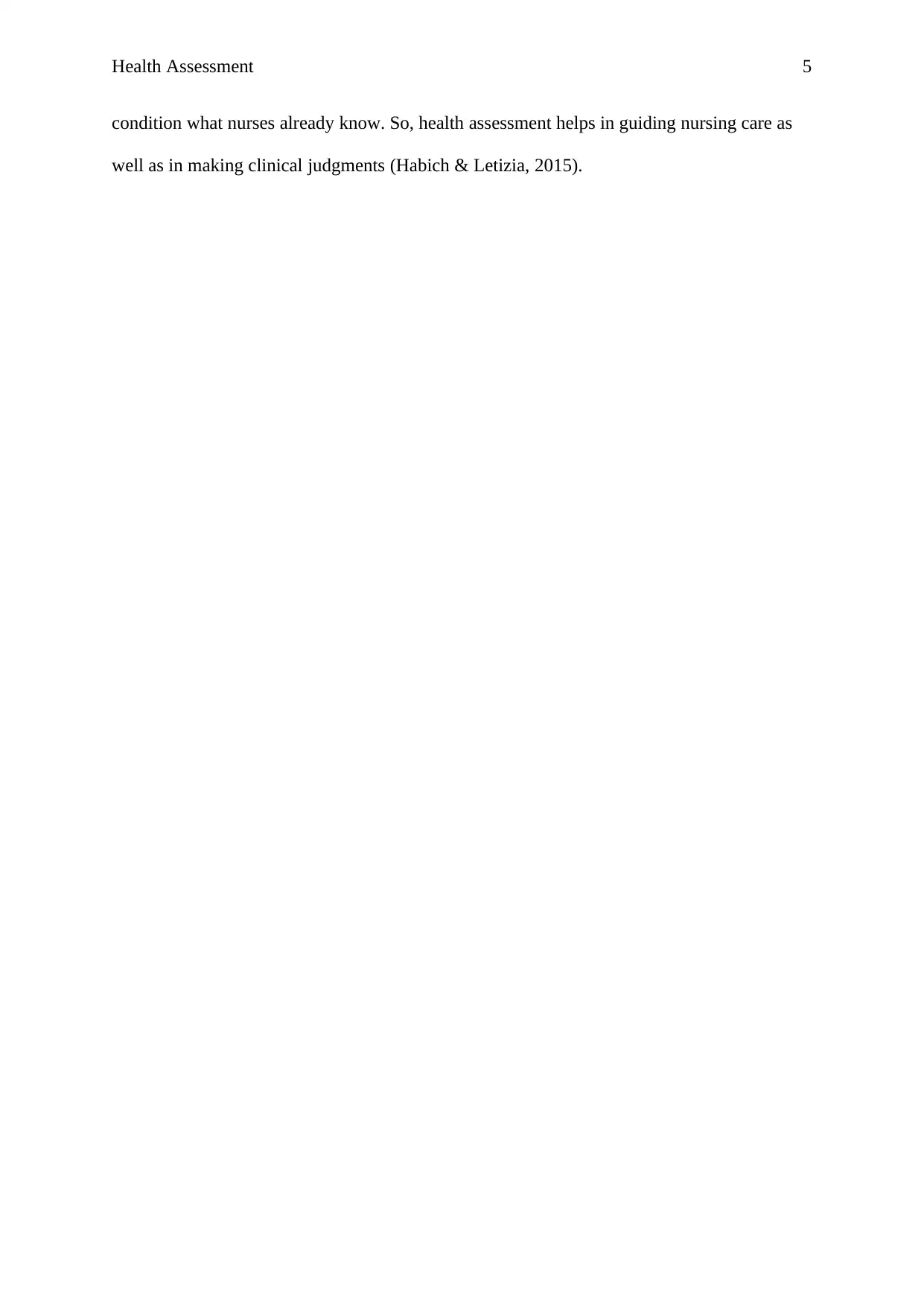
Health Assessment 5
condition what nurses already know. So, health assessment helps in guiding nursing care as
well as in making clinical judgments (Habich & Letizia, 2015).
condition what nurses already know. So, health assessment helps in guiding nursing care as
well as in making clinical judgments (Habich & Letizia, 2015).
⊘ This is a preview!⊘
Do you want full access?
Subscribe today to unlock all pages.

Trusted by 1+ million students worldwide
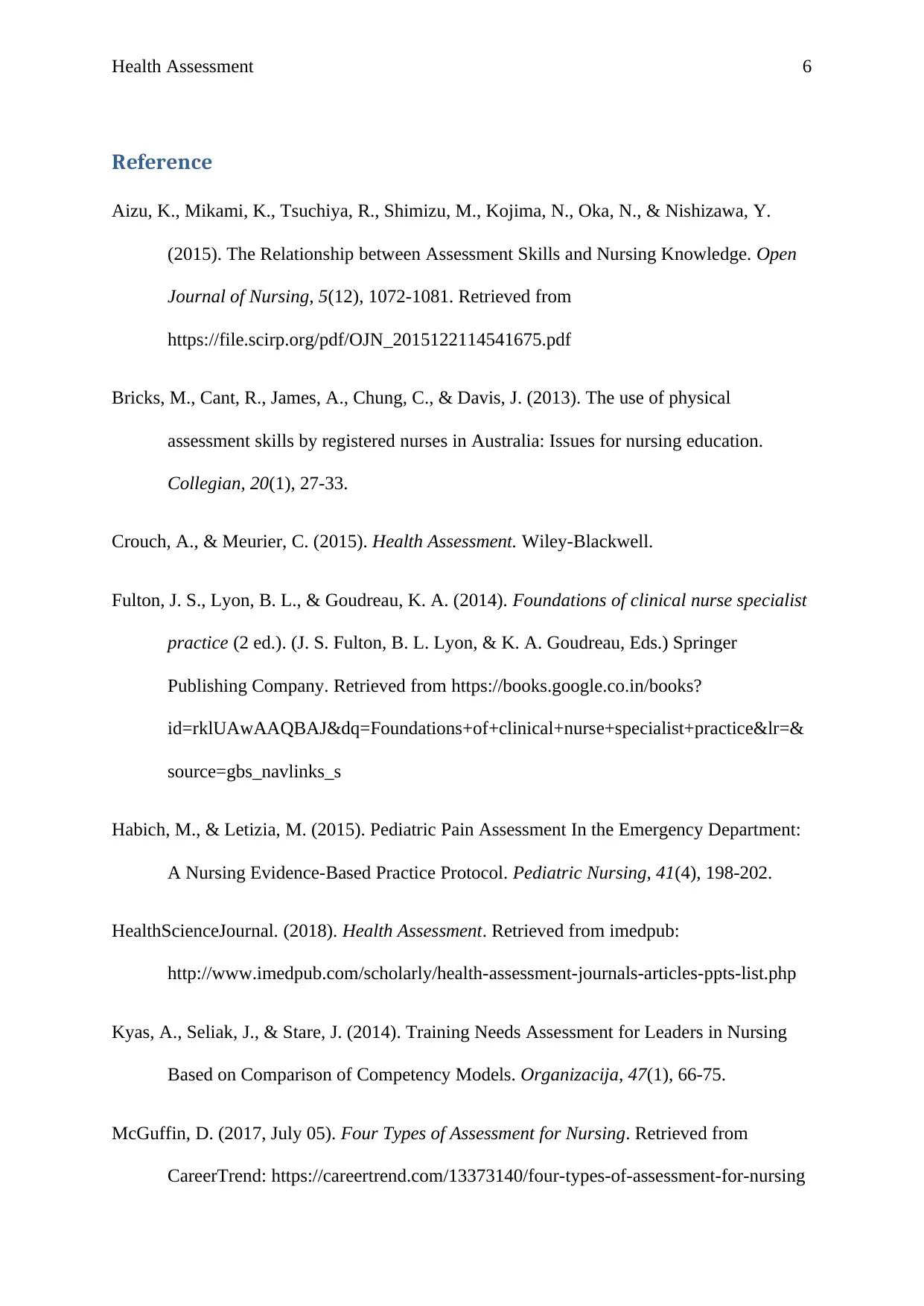
Health Assessment 6
Reference
Aizu, K., Mikami, K., Tsuchiya, R., Shimizu, M., Kojima, N., Oka, N., & Nishizawa, Y.
(2015). The Relationship between Assessment Skills and Nursing Knowledge. Open
Journal of Nursing, 5(12), 1072-1081. Retrieved from
https://file.scirp.org/pdf/OJN_2015122114541675.pdf
Bricks, M., Cant, R., James, A., Chung, C., & Davis, J. (2013). The use of physical
assessment skills by registered nurses in Australia: Issues for nursing education.
Collegian, 20(1), 27-33.
Crouch, A., & Meurier, C. (2015). Health Assessment. Wiley-Blackwell.
Fulton, J. S., Lyon, B. L., & Goudreau, K. A. (2014). Foundations of clinical nurse specialist
practice (2 ed.). (J. S. Fulton, B. L. Lyon, & K. A. Goudreau, Eds.) Springer
Publishing Company. Retrieved from https://books.google.co.in/books?
id=rklUAwAAQBAJ&dq=Foundations+of+clinical+nurse+specialist+practice&lr=&
source=gbs_navlinks_s
Habich, M., & Letizia, M. (2015). Pediatric Pain Assessment In the Emergency Department:
A Nursing Evidence-Based Practice Protocol. Pediatric Nursing, 41(4), 198-202.
HealthScienceJournal. (2018). Health Assessment. Retrieved from imedpub:
http://www.imedpub.com/scholarly/health-assessment-journals-articles-ppts-list.php
Kyas, A., Seliak, J., & Stare, J. (2014). Training Needs Assessment for Leaders in Nursing
Based on Comparison of Competency Models. Organizacija, 47(1), 66-75.
McGuffin, D. (2017, July 05). Four Types of Assessment for Nursing. Retrieved from
CareerTrend: https://careertrend.com/13373140/four-types-of-assessment-for-nursing
Reference
Aizu, K., Mikami, K., Tsuchiya, R., Shimizu, M., Kojima, N., Oka, N., & Nishizawa, Y.
(2015). The Relationship between Assessment Skills and Nursing Knowledge. Open
Journal of Nursing, 5(12), 1072-1081. Retrieved from
https://file.scirp.org/pdf/OJN_2015122114541675.pdf
Bricks, M., Cant, R., James, A., Chung, C., & Davis, J. (2013). The use of physical
assessment skills by registered nurses in Australia: Issues for nursing education.
Collegian, 20(1), 27-33.
Crouch, A., & Meurier, C. (2015). Health Assessment. Wiley-Blackwell.
Fulton, J. S., Lyon, B. L., & Goudreau, K. A. (2014). Foundations of clinical nurse specialist
practice (2 ed.). (J. S. Fulton, B. L. Lyon, & K. A. Goudreau, Eds.) Springer
Publishing Company. Retrieved from https://books.google.co.in/books?
id=rklUAwAAQBAJ&dq=Foundations+of+clinical+nurse+specialist+practice&lr=&
source=gbs_navlinks_s
Habich, M., & Letizia, M. (2015). Pediatric Pain Assessment In the Emergency Department:
A Nursing Evidence-Based Practice Protocol. Pediatric Nursing, 41(4), 198-202.
HealthScienceJournal. (2018). Health Assessment. Retrieved from imedpub:
http://www.imedpub.com/scholarly/health-assessment-journals-articles-ppts-list.php
Kyas, A., Seliak, J., & Stare, J. (2014). Training Needs Assessment for Leaders in Nursing
Based on Comparison of Competency Models. Organizacija, 47(1), 66-75.
McGuffin, D. (2017, July 05). Four Types of Assessment for Nursing. Retrieved from
CareerTrend: https://careertrend.com/13373140/four-types-of-assessment-for-nursing
Paraphrase This Document
Need a fresh take? Get an instant paraphrase of this document with our AI Paraphraser
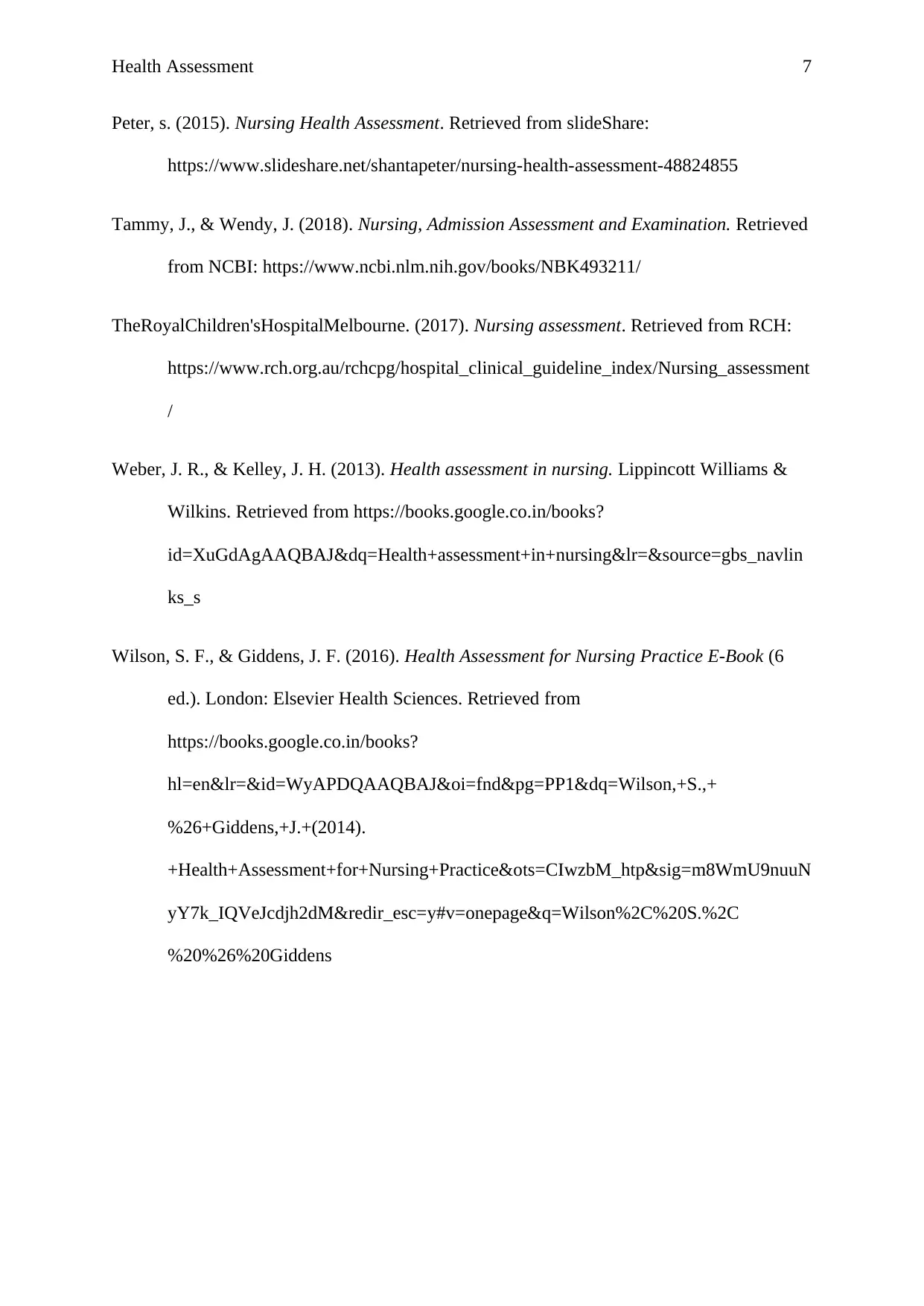
Health Assessment 7
Peter, s. (2015). Nursing Health Assessment. Retrieved from slideShare:
https://www.slideshare.net/shantapeter/nursing-health-assessment-48824855
Tammy, J., & Wendy, J. (2018). Nursing, Admission Assessment and Examination. Retrieved
from NCBI: https://www.ncbi.nlm.nih.gov/books/NBK493211/
TheRoyalChildren'sHospitalMelbourne. (2017). Nursing assessment. Retrieved from RCH:
https://www.rch.org.au/rchcpg/hospital_clinical_guideline_index/Nursing_assessment
/
Weber, J. R., & Kelley, J. H. (2013). Health assessment in nursing. Lippincott Williams &
Wilkins. Retrieved from https://books.google.co.in/books?
id=XuGdAgAAQBAJ&dq=Health+assessment+in+nursing&lr=&source=gbs_navlin
ks_s
Wilson, S. F., & Giddens, J. F. (2016). Health Assessment for Nursing Practice E-Book (6
ed.). London: Elsevier Health Sciences. Retrieved from
https://books.google.co.in/books?
hl=en&lr=&id=WyAPDQAAQBAJ&oi=fnd&pg=PP1&dq=Wilson,+S.,+
%26+Giddens,+J.+(2014).
+Health+Assessment+for+Nursing+Practice&ots=CIwzbM_htp&sig=m8WmU9nuuN
yY7k_IQVeJcdjh2dM&redir_esc=y#v=onepage&q=Wilson%2C%20S.%2C
%20%26%20Giddens
Peter, s. (2015). Nursing Health Assessment. Retrieved from slideShare:
https://www.slideshare.net/shantapeter/nursing-health-assessment-48824855
Tammy, J., & Wendy, J. (2018). Nursing, Admission Assessment and Examination. Retrieved
from NCBI: https://www.ncbi.nlm.nih.gov/books/NBK493211/
TheRoyalChildren'sHospitalMelbourne. (2017). Nursing assessment. Retrieved from RCH:
https://www.rch.org.au/rchcpg/hospital_clinical_guideline_index/Nursing_assessment
/
Weber, J. R., & Kelley, J. H. (2013). Health assessment in nursing. Lippincott Williams &
Wilkins. Retrieved from https://books.google.co.in/books?
id=XuGdAgAAQBAJ&dq=Health+assessment+in+nursing&lr=&source=gbs_navlin
ks_s
Wilson, S. F., & Giddens, J. F. (2016). Health Assessment for Nursing Practice E-Book (6
ed.). London: Elsevier Health Sciences. Retrieved from
https://books.google.co.in/books?
hl=en&lr=&id=WyAPDQAAQBAJ&oi=fnd&pg=PP1&dq=Wilson,+S.,+
%26+Giddens,+J.+(2014).
+Health+Assessment+for+Nursing+Practice&ots=CIwzbM_htp&sig=m8WmU9nuuN
yY7k_IQVeJcdjh2dM&redir_esc=y#v=onepage&q=Wilson%2C%20S.%2C
%20%26%20Giddens
1 out of 8
Related Documents
Your All-in-One AI-Powered Toolkit for Academic Success.
+13062052269
info@desklib.com
Available 24*7 on WhatsApp / Email
![[object Object]](/_next/static/media/star-bottom.7253800d.svg)
Unlock your academic potential
Copyright © 2020–2025 A2Z Services. All Rights Reserved. Developed and managed by ZUCOL.




